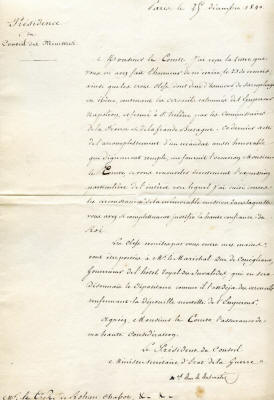908415
Nicholas Jean de Dieu Soult
Duc de Dalmatie
Click on images for larger size
“I have received . . . the three keys of which two have the honor of belonging
to the pewter sarcophagus containing the exhumed coffin of the Emperor Napoleon . . . .”
Nicholas Jean de Dieu Soult, Duc de Dalmatie, 1769–1851. French Minister of War, 1830–1834, 1840–1845; Prime Minister of France, 1832–1834, 1839–1840, 1840–1847; Maréchal–général of the French Army, 1847-1851. Superb content Manuscript Letter Signed, Maréchal, Duc Du Dalmatie, one page, 8” x 12”, with integral leaf attached, Paris, [France], December 29, 1840. In French, with translation.
This is a phenomenally rare and important letter by Soult relating to the retour des cendres—literally, the return of the ashes—the 1840 French expedition to return the body of Emperor Napoleon I to France. Exactly two weeks after Napoleon’s funeral in Paris, Soult writes to Count Philippe Ferdinand-Auguste de Rohan Chabot, who supervised the exhumation on the island of St. Helena, to thank him for the keys to the sarcophagus containing Napoleon’s coffin. In full:
Paris 29 December 1840
The Presidency
of the
Cabinet
Your Lordship, I have received the letter that you have honored me by writing on the 23rd of this month, as well as the three keys of which two have the honor of belonging to the pewter sarcophagus containing the exhumed coffin of the Emperor Napoleon, and closed at St. Helena by the representatives of the governments of France and Great Britain. This last act in the performance of a commission as honorable as it was full of dignity gives me the opportunity, Your Lordship, to remind you specifically of the very special interest with which I have followed all stages of this memorable mission in which you have so completely justified the great faith that the King has in you.
The keys that you have given me will be delivered to Field Marshal, His Grace the Duke of Con égliano, Governor of the Royal Military Pensioners Hospital who from now on will be their holder as he already is of the sealed coffin containing the mortal remains of the Emperor.
I am, Your Lordship, yours very truly,
The President of the Cabinet,
Secretary of State and Minister of War
Maréchal, Duc Du Dalmatie
His Lordship the Count of Rohan Chabot
Following the French defeat at the Battle of Waterloo June 18, 1815, by coalition forces under the command of the Duke of Wellington, Napoleon was imprisoned and exiled on the island of St. Helena, a British territory in the south Atlantic Ocean some 1,250 miles west of Africa and some 4,500 miles from France. He died there May 5, 1821. In a codicil to his will executed less than three weeks earlier, Napoleon expressed his desire to be buried “on the banks of the Seine, in the midst of this French people who loved me so much.” The British governor decided, however, that Napoleon would be buried on St. Helena instead.
By 1840, the French government obtained British permission to return Napoleon’s remains to France. French King Louis-Philippe placed his son, François d’Orléans, prince de Joinville, in command of the expedition to St. Helena. Soult’s predecessor, Prime Minister Louis-Adolphe Thiers, appointed Rohan Chabot, the attaché to the French ambassador to Britain, to supervise the exhumation of Napoleon’s body.
On July 7, 1840, the frigate Belle Poule left France under the command of the prince de Joinville. A candlelit chapel, draped in black velvet embroidered with the Napoleonic symbol of silver bees, and fitted with a catafalque guarded by four gilded wooden eagles, was built in the steerage for Napoleon’s coffin. Rohan Chabot was on board, along with several others. The expedition reached St. Helena on October 8.
The body was exhumed on October 14, 1840. Napoleon had been buried inside of four coffins—a tin inner one surrounded by coffins of mahogany, lead, and mahogany. The outer mahogany coffin had to be broken at the ends to remove the others. Once they were removed, they were placed in a new, neo-classical ebony coffin, brought from France, emblazoned with the word Napoléon in gold, a gilded bronze letter N on each side, and the words Napoléon Empereur mort á Sainte-Hélène le 05 Mai 1821. The inner coffins were then opened.
When the lid was finally removed from the innermost coffin, Napoleon’s body appeared, resting comfortably with his head on a cushion and his forearms and hands on his thighs. His green-cuffed uniform of a colonel of the Chasseurs de la Garde was perfectly preserved, although the buttons were tarnished. His chest bore the red ribbon of the Légion d’honneur, and his hat rested on his thighs. His face was serene, with his eyes fully closed. His chin showed a bluish beard, which emerged due to the dryness of the skin, but his hands were perfectly preserved, with long, white fingernails still attached.
Rohan Chabot and others wept at the sight. On the orders of General Gourgaud, the coffins were resealed. The ebony coffin was sealed inside a new oak coffin designed to protect it. The whole assembly, thus consisting of five coffins, weighed some 2,600 pounds.
The funeral was held in Paris on December 15, 1840. Napoleon rested briefly under the Arc de Triomphe, which Napoleon commissioned in 1806, but which was not completed until 1836. His body was then taken over the Champs Elysees, across the Seine, to the église des Invalides, the Dome church at Les Invalides. A total of 36 sailors from the Belle Poule carried the coffin to the entrance of the church, where they were met by King Louis-Philippe, the Royal Family, and the governor of Les Invalides, Maréchal Bon-Adrien Jeannot de Moncey, 1st Duc de Conegliano, whom Soult mentions in this letter.
Napoleon was entombed inside the chapelle Saint-Jérôme. The body remained there until the present monument, designed by Louis Visconti, was completed in 1861. On April 2, 1861, Napoleon was moved to underneath the center of the dome of the church at Les Invalides.
By all accounts, Napoleon now lies inside a total of six coffins that, in turn, are entombed inside a sarcophagus under the church dome. The five coffins returned from St. Helena thus apparently were placed inside a sixth, which is the pewter sarcophagus that Soult describes in this letter, for interment in the chapelle Saint-Jérôme. The present sarcophagus is of dark red aventurine quartzite, close to porphyry, and rests on a granite pedestal.
This letter is bright and beautiful. It has intersecting horizontal and vertical folds and mounting remnants on the back of the integral leaf and is in fine condition. Were it not for a few small foxing spots, which do not affect either the text or Soult’s signature, we would be tempted to describe it as very fine.
This letter is an extraordinary piece of history that belongs in the finest Napoleonic or French history collection.
Unframed.
_____________
This item has been sold, but
click here to see other
World History items
that we are offering.





